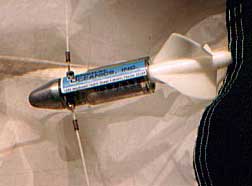2. How do we investigate plankton?
Since most plankton is smaller than we can see, they must be looked at using a microscope. They are usually strained from the water using fine mesh nets or sieves with tiny holes. Typical plankton nets have a round opening and look like a funnel that leads into a collection bucket at the end of the net. The nets are towed behind boats or pulled along beaches.
Different nets are used to capture different kinds of plankton. Small mesh nets must be towed slowly through the water. They capture the tiny plants, phytoplankton, but larger zooplankton (animals) can dart out of their way and avoid being captured. Larger mesh nets can be towed faster to catch zooplankton but allow the phytoplankton to slip through the openings. Sometimes two nets are attached to a single frame and towed together, this type of sampling gear is called a bongo net.
Some phytoplankton is so small that they can not be captured in nets. These are called nanoplankton and are sampled by filtering water through fine filters.
Nets are sometimes rigged with a flow meter that measures the amount of water filtered by the net. This allows the researcher to measure the amount of water filtered and calculate plankton concentration (number of organisms per volume of seawater).

Flow Meter
(Click for larger image)
You can make your own plankton net from a piece of wire and a nylon stocking. Bend the wire (a metal coat hanger works well) into a circle the size of the top of the stocking. Attach the stocking to the wire and you're ready to sample. Pour several buckets of water through the net to collect plankton in the foot of the stocking. Rinse the plankton into a jar and examine it using a microscope or a hand lens.
The amount of phytoplankton in the seawater can also be measured through changes in its color. The color changes with the amount of chlorophyll and other plant pigments present in the seawater. Greener water indicates a higher concentration of plant pigments that come from the phytoplankton. The Airborne Visible/Infrared Imaging Spectrometer (AVIRIS) is an instrument that flies in an airplane and takes images of the water below. It can be used to measure the concentration of chlorophyll in the water. The following image shows the chlorophyll concentration in upper Narragansett Bay, the red color indicates a higher concentration of chlorophyll and therefore phytoplankton.

Narragansett Bay Chlorophyll
(Click for larger image)
| 


